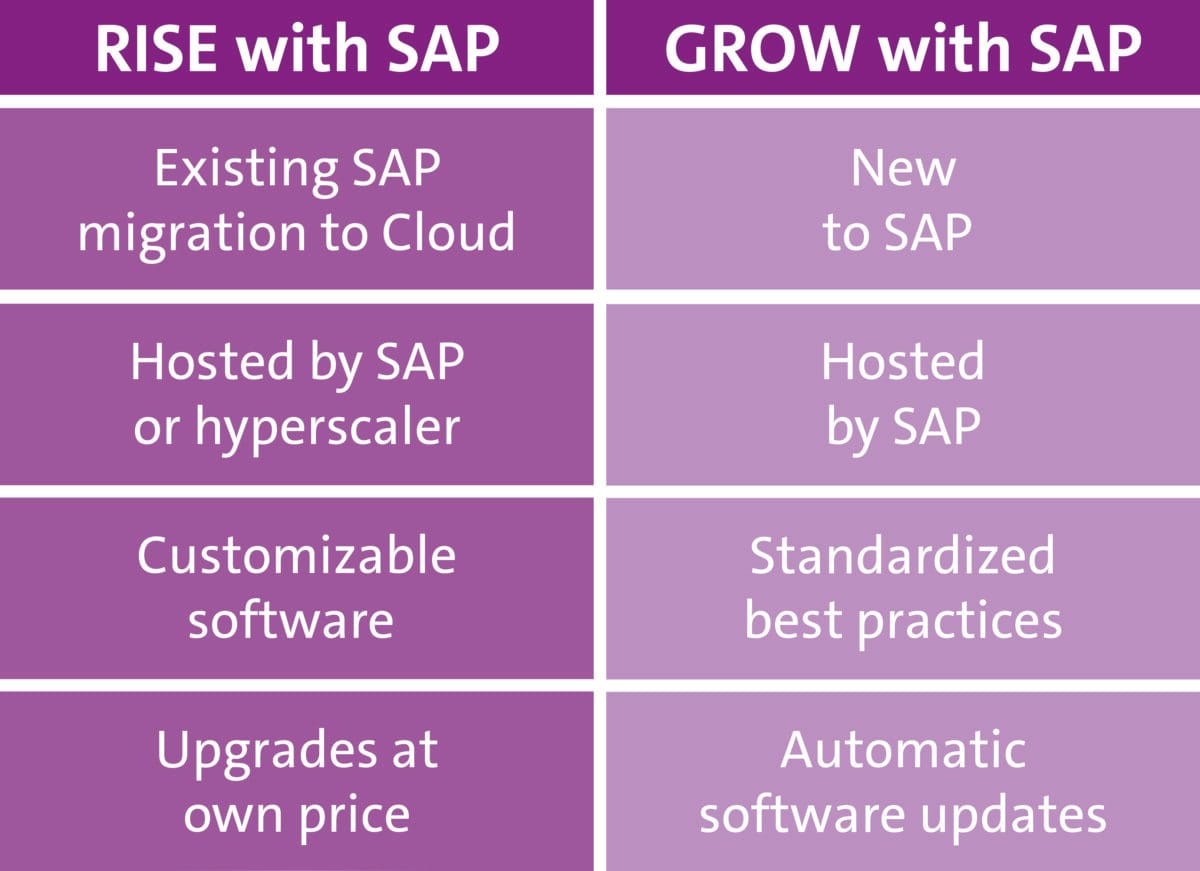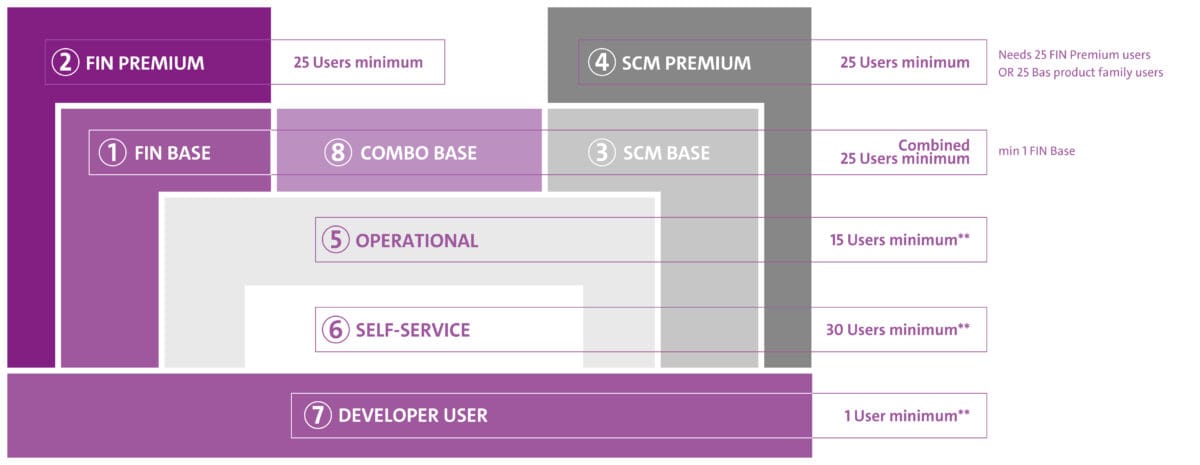Complexity and Opportunities in SAP Licensing Models


SAP took a different approach with the introduction of the cloud solutions: the FUE model (Full User Equivalents) was used here. Instead of licensing individuals or roles directly, a consolidated, role-based usage model was used. Each user role (e.g. employee, power user, self-service user) was weighted with a specific FUE factor. The sum of these factors resulted in the total FUE value, on the basis of which the subscription fee was calculated.
This approach was flexible and scalable, but required a precise understanding of user roles and scenarios within the company. At the same time, the focus shifted from ownership and installation to ongoing use and innovation in the subscription model.
With the increasing shift to the cloud, SAP has also revised its licensing policy several times in recent years and months. In particular, the new models for existing customers (Rise with SAP) and new customers (Grow with SAP) have opened up numerous opportunities for companies, but also new challenges. If you want to fully exploit the potential of the models, you need to understand the different license models and metrics - and actively manage the risks.
Informatics supports companies in making these complex license models transparent and using them optimally.
Two worlds: Rise vs. Grow
SAP is currently pursuing two strategic paths in the cloud business: Grow with SAP and Rise with SAP. Both address different customer groups and starting situations - but are aimed at the same goal: the transformation into a standardized, future-proof cloud ERP.
Grow with SAP is aimed at companies that are new to the SAP world or want to align their business processes as closely as possible to the SAP standard. The basis is the S/4 Hana Public Cloud, which is based on predefined best practices, rapid implementation and automated updates. The model is clearly structured, licensed on a role basis and designed for scalability and efficiency.
Rise with SAP, on the other hand, is designed for companies that are migrating from existing SAP installations and need to transfer complex or customized processes to the cloud. The S/4 Hana Private Cloud Edition is used here, which offers more technical and contractual flexibility and is often implemented in hybrid models. SAP is thus clearly positioning Rise as a transformation path to make even complex scenarios cloud-capable - while Grow represents the long-term target architecture. It is already clear today that the public cloud is the strategic end goal, while Rise with SAP is the necessary intermediate step where the standard logic of the public cloud is not (yet) sufficient.

Business Suite - rethought
Originally, the SAP Business Suite stood for the classic on-premises ERP around SAP ERP 6.0 and supplementary modules such as CRM or SCM. Today, SAP defines it as a modular, cloud-based solution portfolio that integrates central business areas such as finance, supply chain, HR, procurement and customer experience.
The SAP S/4 Hana Cloud always takes center stage, supplemented by solutions such as SuccessFactors, Ariba, Concur and the SAP Business Technology Platform (BTP) as the technological basis.
Instead of a monolithic ERP system, SAP is thus pursuing an open, expandable and AI-supported cloud ecosystem with the reimagined Business Suite, which is geared towards standardization, scalability and continuous innovation. With the current introduction of the new SAP Business Suite packages, the SAP Public Cloud license portfolio has been further developed and aligned more closely with the needs of specialist areas such as Finance, Supply Chain and HR. The existing Full User Equivalent license metric has been replaced by a simpler "per user per month" model. Customers now purchase clearly defined entry-level packages with modularly expandable add-ons, tailored to their typical usage scenarios.
The nested license model
A key feature of the new license structure is the so-called "nested" model. Higher-value licenses automatically include the functions of the lower levels. For example, a "Finance Premium" package not only includes basic functions such as Cash Management or Multibank Connectivity, but also extended tools such as Subscription Billing or SAP Ariba Central Invoice Management. In the "Supply Chain" area, in turn, functions such as Ad-vanced ATP, PLM integration or sustainability solutions are offered in stages based on the selected package level.
Requirement: new license types
Today, SAP defines clearly delineated user groups: for example, operational users, who perform operational tasks such as ordering and service processes, or self-service users with limited rights for functions such as time recording or purchase requisitions. Developer users have comprehensive access to development and customization functions, while combo users combine both financial and supply chain functions. At the same time, SAP has introduced new minimum user quantities. While 15 Full User Equivalents were sufficient in the previous FUE model of the Public Cloud, the new license model now requires at least 25 users when using combined basic packages. For smaller organizations in particular, this can lead to license overhangs and thus to increased barriers to entry.

Opportunity: Modular license models
SAP's modular license structure offers companies more flexibility: licenses can be adapted as required, innovations such as AI or sustainability tools can be integrated and operating costs are easier to plan. However, this openness also entails risks. User roles from the on-premises world cannot always be transferred directly. Over-licensing often occurs when modules are activated but hardly used. The large number of possible packages makes it difficult to maintain an overview and changes to SAP metrics can result in unexpected additional costs.
An early comparison between requirements and license model is essential. Transparency regarding existing licenses, regular optimization of user roles and contractual extension options help to control costs. Support from experienced partners can also help to develop the right license strategy.
Conclusion:
The new SAP license model offers a structured but also challenging basis for digital transformation in companies. Those who get to grips with the licensing models, user roles and packages at an early stage can realize not only the technological but also the economic benefits of the SAP Cloud ERP world. By combining modularity, transparency and innovation, the SAP Business Suite becomes a powerful tool - provided companies master the complexity.







